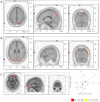Interpersonal body and neural synchronization as a marker of implicit social interaction
- PMID: 23233878
- PMCID: PMC3518815
- DOI: 10.1038/srep00959
Interpersonal body and neural synchronization as a marker of implicit social interaction
Abstract
One may have experienced his or her footsteps unconsciously synchronize with the footsteps of a friend while walking together, or heard an audience's clapping hands naturally synchronize into a steady rhythm. However, the mechanisms of body movement synchrony and the role of this phenomenon in implicit interpersonal interactions remain unclear. We aimed to evaluate unconscious body movement synchrony changes as an index of implicit interpersonal interaction between the participants, and also to assess the underlying neural correlates and functional connectivity among and within the brain regions. We found that synchrony of both fingertip movement and neural activity between the two participants increased after cooperative interaction. These results suggest that the increase of interpersonal body movement synchrony via interpersonal interaction can be a measurable basis of implicit social interaction. The paradigm provides a tool for identifying the behavioral and the neural correlates of implicit social interaction.
Figures



References
-
- Bernieri F. J. & Rosenthal R. Fundamentals of nonverbal behavior. (Cambridge University Press, 1991).
-
- Burgoon J. K., Stern L. A. & Dillman L. Interpersonal adaptation: Dyadic interaction patterns. (Cambridge Univ Pr, 1995).
-
- Schmidt R. & Richardson M. Coordination: Neural, behavioral and social dynamics. (Springer, 2008).
-
- Neda Z., Ravasz E., Brechet Y., Vicsek T. & Barabasi A. L. Self-organizing processes: The sound of many hands clapping. Nature 403, 849–850 (2000). - PubMed
-
- Kirschner S. & Tomasello M. Joint drumming: Social context facilitates synchronization in preschool children. Journal of experimental child psychology 102, 299–314 (2009). - PubMed
Publication types
MeSH terms
Substances
LinkOut - more resources
Full Text Sources
Other Literature Sources
Medical
Molecular Biology Databases

